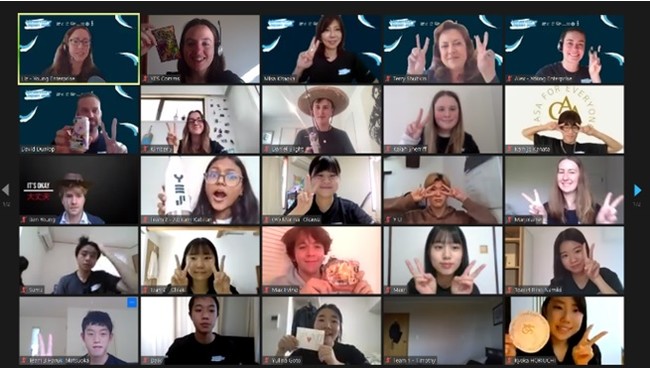ニュージーランド国内の高校生5名が、初開催の「BizVentureプログラム」で優勝者に選ばれました。このプログラムは、Education New Zealand(ニュージーランド政府の留学促進機関)と日本のパートナー企業が、ニュージーランドと日本の学生に、国連の「持続可能な開発目標」を達成するためのビジネスソリューションを考える機会を提供することを目的とした試験的な取り組みです。
ニュージーランドと日本から選ばれた40名の学生*は、9月18日から20日までの3日間、バーチャル交流会に参加し、日本の差し迫った社会問題を解決するための課題を1つ選び、ビジネスプランを設計して「dragon’s den(投資家が投資家にビジネスアイディアをプレゼンして資金を獲得するイギリスのテレビ番組)」スタイルで審査員に発表しました。
各チームは、「相対的貧困」「ジェンダー平等」「若者のメンタルウェルビーイング(精神的な健康)」をテーマにした3つの課題のうち1つに答えました。
優勝したニュージーランドチームは、ネイピアのタラデール高校のハミッシュ・ロビンソン、タウランガ・ボーイズ・カレッジのBenjamin Young、ネルソンのワイメア・カレッジのDaniel Blight、サウスランド・ガールズ・ハイスクールのKaiah Sherriff、オークランドのパクランガ・カレッジのAbirami Kabilanで構成され、日本の10代の精神的な健康を良くするための解決策に取り組むことを選択しました。

ユニセフの報告書によると、生活満足度や自殺率などの項目で評価した子どもの精神的健康度は、OECD加盟国41カ国中、日本は37位です(ニュージーランドは38位)。
ニュージーランドの学生たちは、日本の若者の間でメンタルヘルスに関するポジティブな会話を促進することを目的とした、「大丈夫」という名の持続可能なアパレルブランドを開発するというコンセプトを提案し、成功を収めました。また、ウェルビーイングに関する重要なメッセージを発信するために、日本の高リーチなインフルエンサーの支持を得たいという野望もあります。
自分たちのビジネスプランについて、「衣料品ブランド自体は特にクリエイティブなものではありませんが、メンタルヘルスの重要性についてのメッセージを発信する手段として衣料品を使用するというアイデアは、クリエイティブだと思います。」と説明しています。「衣服を使ってメッセージを発信することは、メンタルヘルスにネガティブなスティグマがある日本では、ユニークなことだと思います。」
17歳のAbirama Kabilanさん(パクランガカレッジ)は、自分のベンチャーについて以下のように語りました。「国連のSDGsは、現在の人類が直面している最大の問題であり、それに取り組むことはかなり徹底した作業でした。しかし、数人の若者が頭を寄せ合うことで何が起こるのかを知ることができたのは、素晴らしいことでした。SDGsは相互にリンクしており、一つの目標に取り組むことで、他の目標を達成するためのより良いポジションを得ることができるということを、私たちは認識しました。」
Kabilanさんは、日本のビジネスや社会文化に触れたことで、目が覚めたと言います。
「この異文化体験で最も興味深かったのは、日本の学生たちが同じ問題にどのように取り組んでいるかを見たことです。世界中の他の国の若者も、このような問題に対するアプローチの仕方は様々でしょうから、みんなで協力したら、どのようなアイデアが出てくるか想像してみてください。」
一方、日本の受賞チームは、日本のワーキングマザーの社会的な課題である、家事や育児を積極的に行う父親をサポートする新しいアプリのビジネスケースを開発しました。この課題は、日本がジェンダーギャップ指数で120位とG7諸国の中で最悪であることや、日本政府が2020年までに上級管理職に占める女性の割合を30%に引き上げるという目標を達成できていないこと(現在は15%)を受けて設定されました。
二国間の協力関係のもと、学生たちは週末にニュージーランドと日本のゲストスピーカー、文化メンター、言語コーチとのインタラクティブなワークショップを通じて、両国のビジネスや文化に触れ、ピッチの準備を行いました。
ENZのプログラムは、留学生の渡航が制限されているニュージーランドと日本の外交関係を継続的に構築することを目的としています。
「日本とニュージーランドは何十年にもわたって永続的なパートナーシップの恩恵を受けており、来年は外交関係樹立70周年を迎えます。教育は、人と人とのつながりを育み、2021年現在の両国の非常に密接な関係の発展を支える上で、実に重要な役割を果たしてきました。」と、駐日ニュージーランド大使のヘイミッシュ・クーパー(Hamish Cooper)氏は述べています。
「パンデミック以前は、毎年1万人以上の日本の学生がニュージーランドに留学しており、重要な経済的貢献をしているだけでなく、学校や地域社会を豊かにし、ニュージーランドの学生がよりグローバルに活躍できる手助けとなっていました。」
この試験的プログラムの成功を受けて、BizVentureの共同研究者は2022年に向けてより大きな計画を立てています。
Education New Zealandの日本担当ディレクターである北岡美沙氏は、「将来的には、各国で直接BizVentureを開催し、優勝チームがお互いの国を訪問することを計画しています。」と述べました。「私たちは、学生の旅費を支援したり、彼らのビジネスアイデアを市場で実現するために、両国のビジネス支援団体のリーダーや組織と協力して、資金調達を行うことを計画しています。」
また、BizVentureは、国連の持続可能な開発目標の達成に向けて、ニュージーランド政府と日本政府が一体となって取り組んでいることを示す重要なイベントでもあります。
























































-helped-regain-her-strength-and-balance-using-Nymbl-after-a-fall.-660x440.jpg)


